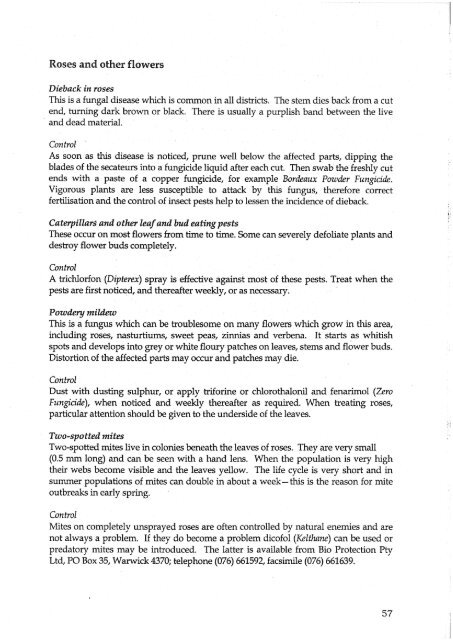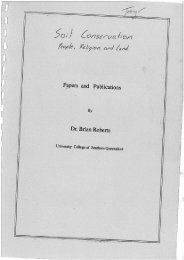western-queensland-gardening-guide.pdf - South West NRM
western-queensland-gardening-guide.pdf - South West NRM
western-queensland-gardening-guide.pdf - South West NRM
Create successful ePaper yourself
Turn your PDF publications into a flip-book with our unique Google optimized e-Paper software.
Roses and other flowers<br />
Dieback in roses<br />
This is a fungal disease which is common in all districts. The stem dies back from a cut<br />
end, turning dark brown or black. There is usually a purplish band between the live<br />
and dead material.<br />
Control '<br />
As soon as this disease is noticed, prune well below the affected parts, dipping the<br />
blades of the secateurs into a fungicide liquid after each cut. Then swab the freshly cut<br />
ends with a paste of a copper fungicide, for example Bordeaux Pozi~der Fungzcide.<br />
Vigorous plants are less susceptible to attack by this fungus, therefore correct<br />
fertilisation and the control of insect pests help to lessen the incidence of dieback.<br />
Caterpillars and other leaf and bud ea fing pests<br />
These occur on most flowers from time to time. Some can severely defoliate plants and<br />
destroy flower buds completely.<br />
Control<br />
A trichlorfon (Dipterex) spray is effective against most of these pests. Treat when the<br />
pests are first noticed, and thereafter week*, or as necessary.<br />
Powdery mildew<br />
This is a fungus which can be troublesome on many flowers which grow in this area,<br />
including roses, nasturtiums, sweet peas, zinnias and verbena. It starts as whitish<br />
spots and develops into grey or white floury patches on leaves, stems and flower buds.<br />
Distortion of the affected parts may occur and patches may die.<br />
Control<br />
Dust with dusting sulphur, or apply triforine or chlorothalonil and fenarimol (Zero<br />
Fungicide), when noticed and weekly thereafter as required. When treating roses,<br />
particular attention should be given to the underside of the leaves.<br />
Two-spotted mites<br />
Two-spotted mites live in colonies beneath the leaves of roses. They are very small<br />
(0.5 mrn long) and can be seen with a hand lens. When the population is very high<br />
their webs become visible and the leaves yellow. The life cycle is very short and in<br />
summer populations of mites can double in about a week- this is the reason for mite<br />
outbreaks in early spring.<br />
Control<br />
Mites on completely unsprayed roses are often controlled by natural enemies and are<br />
not always a problem. If they do become a problem dicofol (Kelthane) can be used or<br />
predatory mites may be introduced. The latter is available from Bio Protection Pty<br />
Ltd, PO Box 35, Warwick 4370; telephone (076) 661592, facsimile (076) 661639.
















